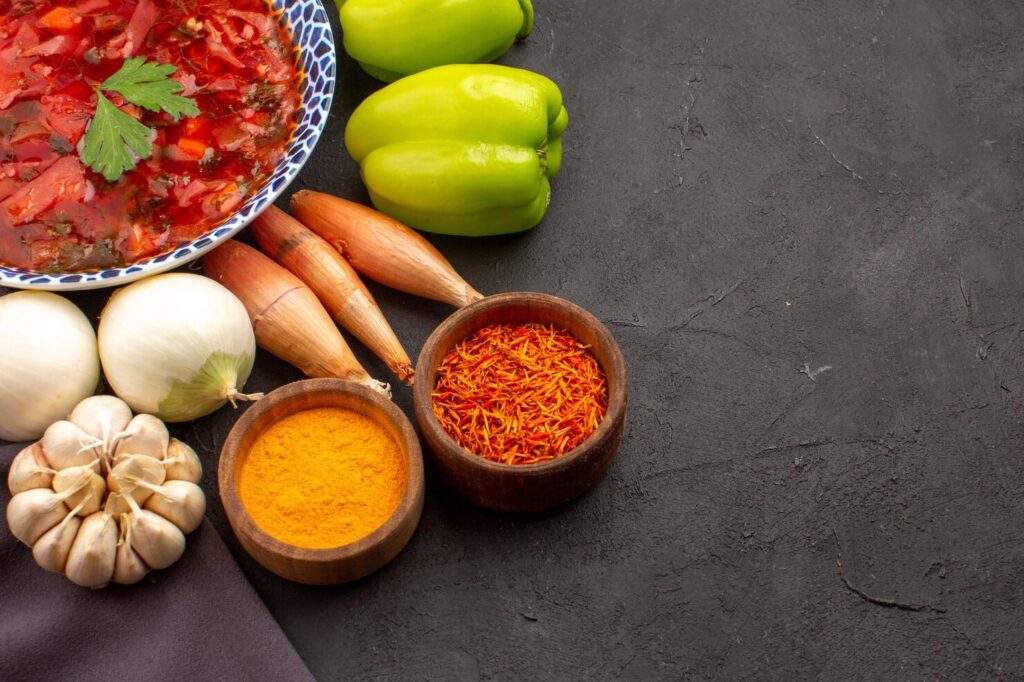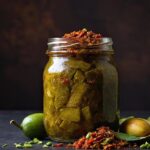If you’ve ever tasted the bold and fiery flavours of Andhra cuisine, you know it’s a world of spice, tang, and aroma. But what gives these dishes their unmistakable taste? The secret lies in Andhra kitchen ingredients, everyday items that form the backbone of traditional Andhra cooking.
Whether you’re an aspiring cook or a food lover wanting to recreate authentic flavours at home, here’s a step-by-step look at the Andhra food staples and Indian pantry items you should always keep stocked.
1. What Are the Essential Andhra Kitchen Ingredients for Everyday Cooking?
The foundation of Andhra cuisine lies in balance, between heat, tang, and earthiness.
The must-have Andhra kitchen ingredients include:
- Tamarind: Adds a signature tang to curries and chutneys.
- Red Chillies: Andhra’s fiery heart, used in powders, pickles, and tempering.
- Turmeric Powder: Adds both colour and healing benefits.
- Curry Leaves: Bring aroma and freshness to tempering.
- Mustard Seeds & Cumin: Key for traditional tadka (tempering).
These Andhra food staples aren’t just flavour boosters, they also reflect the region’s Ayurvedic approach to food, where each spice plays a role in digestion and wellness.
2. What Spices Define Authentic Andhra Cuisine?
Spices are the soul of Andhra cooking. Unlike mild cuisines, Andhra dishes embrace heat boldly.
Stock up on these Andhra kitchen ingredients for your spice rack:
- Guntur Red Chillies: Famous for their bright colour and medium heat.
- Coriander Seeds: Add a nutty depth to spice blends.
- Fenugreek (Methi) Seeds: Used sparingly for bitterness and gut health.
- Asafoetida (Hing): A pinch transforms lentil-based dishes.
- Black Pepper: Complements the pungency of chillies.
When combined, these spices create the distinct flavour layers that make Andhra food staples so irresistible.
3. What Pulses and Lentils Are Common in Andhra Cooking?
No South Indian kitchen is complete without lentils, the heart of vegetarian meals.
Popular Andhra food staples include:
- Toor Dal (Pigeon Pea Lentils): Used in pappu (Andhra-style dal).
- Urad Dal (Black Gram): Essential for dosa and vada batters.
- Moong Dal (Yellow Lentils): Light and easy to digest.
- Chana Dal (Split Chickpeas): Adds crunch to snacks and upma.
These Indian pantry items provide the protein and texture needed for everyday meals, making them indispensable in any Andhra kitchen.
4. Why Is Tamarind So Important in Andhra Food Staples?
Tamarind defines Andhra cuisine like no other ingredient.
From pulusu (tamarind-based curry) to rasam (sour soup), its tangy punch balances spice and sweetness. Tamarind also acts as a natural preservative in pickles, a must-have among Andhra kitchen ingredients.
Pro tip: Always store tamarind paste in an airtight container in your pantry for long-lasting freshness.
5. What Are the Must-Have Grains and Rice Varieties for Andhra Meals?
Rice is central to Andhra cuisine, serving as the base for nearly every meal.
Top Andhra food staples to stock include:
- Sona Masoori Rice: The most loved Andhra rice variety.
- Idli Rice: Used for fluffy idlis and crisp dosas.
- Millets (Ragi, Jowar, Foxtail): Popular for health-conscious meals.
These Indian pantry items ensure your Andhra dishes have the perfect foundation, soft, aromatic, and satisfying.
6. What Oils and Ghee Are Traditionally Used in Andhra Cooking?
Oil choice is crucial in enhancing flavours.
Traditional Andhra kitchen ingredients include:
- Gingelly (Sesame) Oil: Adds richness and aroma to pickles.
- Groundnut Oil: Common for deep frying and sautéing.
- Ghee (Clarified Butter): Used in tempering and sweets for its aroma.
These oils not only enhance flavour but also carry Ayurvedic benefits, making them vital Andhra food staples.
7. Which Pickles and Chutneys Are Pantry Must-Haves?
Every Andhra meal is incomplete without a spicy pickle or chutney.
Popular Indian pantry items in Andhra homes include:
- Gongura Pickle: Made from sorrel leaves, famous for its tangy bite.
- Mango Avakaya: Fiery, tangy, and iconic to Andhra households.
- Tomato Pachadi: Adds freshness to rice and idlis.
These condiments are more than side dishes, they embody the soul of Andhra cuisine and its love for bold flavours.
8. What Are Some Lesser-Known Andhra Kitchen Ingredients Worth Trying?
Beyond the basics, Andhra kitchens also use:
- Drumstick (Moringa): Adds unique aroma and nutrients to sambar.
- Snake Gourd and Ridge Gourd: Used in light curries.
- Coconut: Fresh or dried, for chutneys and gravies.
These Andhra kitchen ingredients deepen the regional authenticity of your meals.
9. How to Store Andhra Food Staples for Freshness
Proper storage ensures longevity of your Andhra kitchen ingredients:
- Keep spices in airtight glass jars away from sunlight.
- Store lentils and rice in cool, dry containers.
- Refrigerate tamarind, ghee, and pickles for extended freshness.
Maintaining these Indian pantry items properly guarantees flavour and quality in every dish.
10. How to Start Building Your Andhra Kitchen Pantry
If you’re new to Andhra cooking, begin with these 10 essentials:
- Tamarind
- Guntur Red Chillies
- Toor Dal
- Curry Leaves
- Mustard Seeds
- Sona Masoori Rice
- Fenugreek Seeds
- Gingelly Oil
- Turmeric Powder
- Gongura Pickle
With these Andhra food staples, you can recreate the authentic flavours of Andhra meals in your own kitchen.
Faqs
What are the main Andhra kitchen ingredients?
Tamarind, red chillies, mustard seeds, lentils, rice, and ghee are among the most important Andhra kitchen ingredients used daily.
What makes Andhra food staples unique?
Their bold use of spice and tangy balance makes Andhra food staples distinct from other Indian cuisines.
Are Andhra ingredients easy to find?
Yes, most Indian grocery stores carry essential Andhra kitchen ingredients like tamarind, curry leaves, and Sona Masoori rice.
Can I substitute Andhra food staples with regular Indian pantry items?
You can, but authentic Andhra flavours come from region-specific ingredients like Guntur chillies and gongura leaves.
What are the healthiest Andhra kitchen ingredients?
Lentils, millets, turmeric, and sesame oil are highly nutritious and form the base of many traditional dishes.








